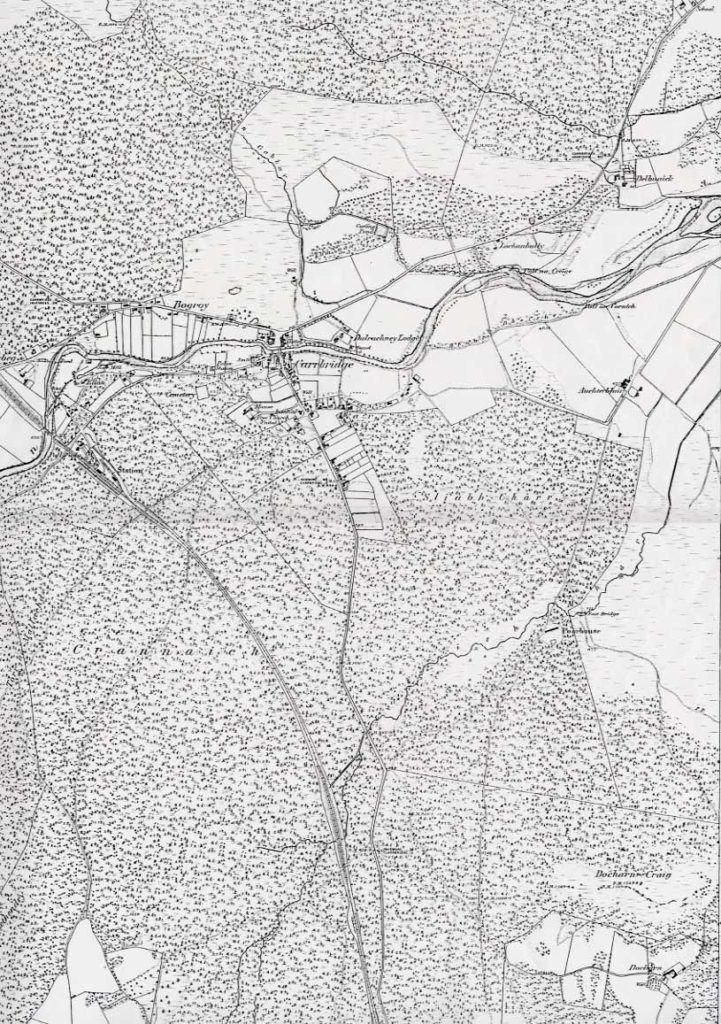1808 Village Plan
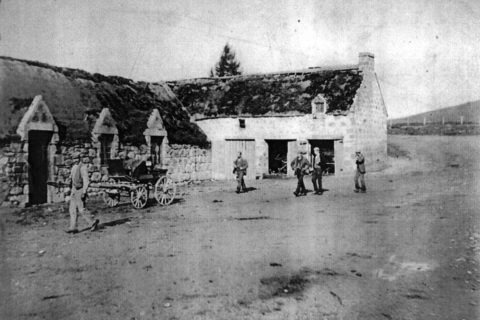
In 1808 a “Plan of the Intended Village at the Bridge of Carr” was drawn out. At this time, the inhabitants of Duthil Parish lived at DALNAHAITNACH, FOREGIN and SLOCHD. The Old Bridge of Carr had been built in 1717 as a foot bridge. . In 1791 a new toll bridge built for wheeled transport, bore first the Kinveachy to Dulsie Bridge military road and from 1803, the Perth – Inverness road as well. The ‘T’ junction at the new bridge was seen as a “settlement-site-in waiting.”
The first building near the Bridge was an Inn. The first Inn-keeper was George Ellis, junior, son of a Huntly weaver who had moved to Grantown to supervise the work at the Grantown -on -Spey Linen Company’s factory. There were 70 plots on the 1808 village plan which included one-and-a half-acre plots North of the Bridge. These plots were in effect small crofts on Bogroy land along the new main road ( Inverness Road). The “croft” plots were let quite quickly but by 1860, only about a dozen plots had been developed South of the bridge. It was not until the opening of the Aviemore to Inverness spur of the Highland railway line in 1898 that Carr Bridge advanced from being a hamlet to becoming a village. An old holiday guide refers to Carr Bridge as, “A quiet holiday village on the fringes of nowhere in particular” – but 150 years after the 1808 plan was drawn up, Carr Bridge would be booming as the first ski-centre in Scotland.
World Wars I & II
During the first World War (1914-18) 400 German Prisoners of War were in camp at Inverlaidnan. They were employed felling timber.
A company of the Canadian Forestry Corps were stationed in Duthil during the 1939-45 War. They were employed in timber felling. They were known locally as “Newfies” They lived at first in the village hall then built Camp No 1 – Newfy-style log huts built of unfinished treetrunks of young trees, with gaps stopped up with moss.
Many married local girls who accompanied their husbands to Canada after the war. About 10 ‘Newfs’ settled in the Parish.
The ‘Newfies’ displayed their physique and bravado by jumping off the Old Coffin Bridge into the deep pool – a dangerous act still practised to this day by local youngsters.
In May 1940 the British Government appealed for civilian volunteers to form a HOME GUARD “to assist in the defence of the British Isles if and when the German forces attempted an invasion.” Large numbers of men from the Forestry Units volunteered.
By 1942, the less well-defended areas of the North East of Scotland were considered to be vulnerable to invasion and so the military authorities felt that there was a need for a mobile force which could be assembled and moved at very short notice in the event of an invasion. Another appeal for volunteers went out to the foresters and within a fortnight, the 3rd Inverness (Newfoundland) Battalion Home Guard, had a complement of over seven hundred men. It was the only Home Guard Unit composed entirely of men from overseas who were serving in Britain on specialised war work.
All training and exercises were carried out after working hours, at week-ends and during leave. An assault course and rifle range were constructed at an abandoned logging site at Carrbridge. This training ground was used extensively by other Home Guard and regular army units.
The British Home Guard was officially “stood down” on 31st December 1944, and the Newfoundland Battalion was represented at the National Home Guard stand-down parade in London that year.
All members of the Forestry Unit who volunteered and served in the British Home Guard were awarded the Defence Medal
Schools
Prior to the opening of today’s Carrbridge Primary School in 1990, the school for the village was Duthil School – one and a half miles from the village on the Grantown road. Duthil School was built in 1877. There had also been a school at Balnastraid (near Duthil Church) which was the first in the district, dating from the late 18th century. There was also a girls’ school at The Glebe before it became church property.
To the west of the Parish, a school at Battan served the children from Battan and Foregin (off the Inverness road near Battan Burn). Beside the ruin of this school is another ruin which was once a hospital. it was used to tend casualties among men working on the building of the Highland Railway.
Farther west there was a school at Inverlaidnan to serve Dalnahaitnach. This school moved to Incharn, farther north, and in 1905 the children moved to a school at Slochd. The latter closed in 1959 and was demolished.
Bridges
Bridge of Carr
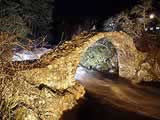
Erected by Brigadier-General Sir Alexander Grant of Grant in 1717 for estate purposes to provide passage for foot passengers, horses and stock and for funerals to Duthil Churchyard, hence its other local name “the coffin bridge”. The bridge took six months to built and cost £100. The specification for the bridge stated that it should be of “ane reasonable Breadth and Height as will Receive the water when in the greatest speat.” And it is – only the parapets of this bridge were washed away in the muckle spate of 1829.
A bridge for wheeled traffic – a toll bridge – was built in 1791 where the present bridge is now. The present bridge was built in the 1970s.
Sluggan Bridge
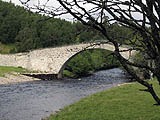
Up river via Station Road towards Dalnahaitnach, Sluggan Bridge was the second bridge to be built at this point on the river. General Wade’s military road, built in 1728 is about 2 miles up Station Road. To the North, the road runs down to Sluggan where the road crosses the Dulnain and continues on through to Slochd.
Wade originally crossed the Dulnain with a ford which was later replaced in the 1760s with a low two-arch bridge. This was swept away during the great flood of the 3rd August 1829, to be replaced by the current large single span bridge in the 1830s.
Major repairs were carried out to the bridge in 2001/02 by Sustrans as part of the National Cycle Network. Sluggan Bridge is category A listed and a scheduled monument. The Wade Road is an ancient right of way.
Ellan Bridge
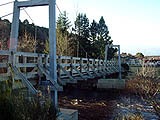
The present suspension wooden bridge which crosses the river Dulnain between Dalrachney Beag and Ellan (access from Station Road or along the river bank from the Old Garage) was erected in 1992 by Ghurka soldiers who lived in the village hall while the work was carried out. It replaced an old bridge which had become unsafe.
Churches
Duthil Church, Carrbridge
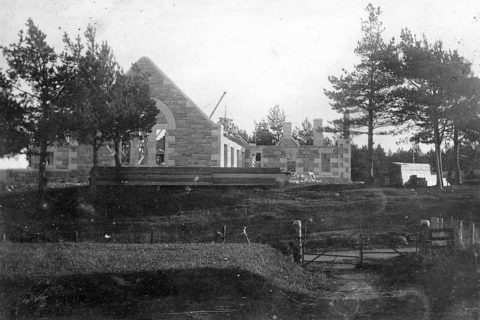
Opened in August, 1909. In 1976 it underwent a transformation with the completion of an extensive renovation scheme costing £7,609.
It included the remodelling of the chancel to house the pulpit, Communion table and chair, from the disused OLD PARISH CHURCH AT DUTHIL. The pulpit is a memorial to the Rev. William Grant – an ancestor of Lady Turnbull, Reidhaven, Grantown – who had a long ministry in Duthil. The Communion table is in memory of the Rev Patrick Grant, minister of Duthil in the late 18th and early 19th Centuries. From him were descended through his daughter, a number of distinguished people who are commemorated by Duthil memorial tablets. They include Field Marshall Sir Patrick Grant and General Sir Henry Fane Grant.
These tablets were “rescued” and placed in the Duthil Chapel – formed in what was the rear of Carr Bridge Church – also on display there are the memorial tablets and rolls of honour which were previously elsewhere in the Carr Bridge building.
The transept, was closed off to form a church hall A feature of the renovation is the panelling at the back of the chancel, which is floodlit, and the cross which is lit from the rear.
The Woman’s Guild provided a red carpet in the chancel.
Oil-fired central heating was installed, boosted by radiators from Old Duthil Church.
The renovated church was dedicated by the Rev Dr Horace Walker, Secretary of the Church of Scotland Home Board.
The opening ceremony, was performed by the Moderator of the Presbytery of Abernethy, the Rev. James Boyd, Nethybridge.
Old Parish Church – Duthil
The first recorded Church at Duthil was built about 1400 (probably on the site of an earlier building).
The present church was built on the same site in 1826. The first of the two Grant of Grant Mausoleums beside the Church was built in 1837. The first Chief of Grant to be interred at Duthil was James Grant, third of Freuchy whose Last Will & Testament, dated 1553. ordered that he be buried in the Parish Church of Duthil.
He died and was interred here in 1585.
The first Protestant minister, William Fraser, was inducted at Duthil in 1614, 54 years after the Reformation. The Church which was dedicated to St Peter has been rebuilt on several occasions; it was renovated just before World War I by Dr Macgregor Chalmers.
In 1843 came the Disruption – the breaking away of the Free Church from the Established Church. After this the “Men of Duthil” – Presbyterians and their followers, worshipped in the open woods at Duthil for three hours every Sunday for seven years, Summer and Winter until the Free Church was built in 1850. Its first minister was a Rev John Logan. Other sections of the church broke away from the Free Church in 1893 and a Union of the Free Churches was effected in 1900
In 1909, the United Free Church built a church and manse in Main Street, Carr Bridge.
In 1930 the Church of Scotland and the Free Churches united.
The Free Church was sold in 1963 and services were held in the church hall which is situated on the road up to the old church (now Fairwinds Hotel)
Old Duthil Church closed for services in 1967 and from 4th March 1969 Duthil Church was deemed no longer in use. It was sold in 1974.
19th & 20th Centuries’ Religious Conduct
In 1880 Conduct on a Sunday was a serious business……
To read Shakespeare or Scott on a Sunday was an unforgivable sin – however to indulge in charitable gossip with your neighbour was allowed.
It was permissible to cut tobacco with a knife, but NOT to cut string or stick or vegetable for the broth. You daren’t peel potatoes on a Sunday before cooking them.
You might wash your face on the Lord’s Day but you were heading straight for perdition if you shaved or cut your nails.
If boots were left unpolished on Saturday night, then unbrushed they had to remain over Sunday if you wanted to escape eternal punishment – but you might brush your beard without risk.
There was no sin in taking horses to water to drink, but you might not take water to the horses.
In 1916 a call from the heads of the church for a total prohibition during wartime and until demobilisation was given support by the Kirk Session in the hope that the Government would at once close the doors from which this terrible evil came forth. Then and only then might we deservedly expect to win the war.
Heroes & Men of Distiction
Iain Beag Macandra of Dalnahaitnach (Little John Macandrew)
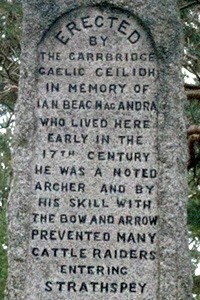
As his Gaelic name implied, Iain Beag Macandra was a small man of Tom Thumb size. But a great archer. Mid 17th century, he joined Rose of Kilravoch* who was pursuing Mackintoshes who had plundered Rose’s cattle. In the ensuing battle in Strathdearn, Macandrew killed the Chief of the reivers with an arrow. Macandrew knew that the reivers would want their revenge and follow him home. Later, when John saw strangers in the woods near Dalnahaitnach he guessed they had come to avenge their Chief’s death.
The strangers, thinking John was just a young lad, offered him a bribe to take them to Ian Beag Macandra’s house (his own). John took the bribe. When they reached his house, John’s wife was in and with great presence of mind, carried on the deception and told the strangers that her husband was out . She gave the strangers food and drink and sent John out to look for the master.
John climbed to the top of a tree near the door of his house. In the tree he kept a bow and a supply of arrows. He cried out that the master was coming. The strangers hurried out one by one and as they did, John shot each one with an arrow.
A Monument to Iain Beag Macandra was erected in memory of his great skill and cunning with the bow. It stands on the North side of the river Dulnain at Dalnahaitnach.
* Kilravoch Castle (pronounced “killrock”) has been the family seat of the Clan Rose since 1460. The present Chief of Clan Rose is Miss Elizabeth Rose, 25th Baroness. The gardens are renowned for a variety of trees, some centuries old. Kilravoch Castle is near Cawdor, Darnaway and Brodie Castles.
Professor Henry Calderwood Of Ardnacoille, Station Road.
Born Peebles, 10th May 1830. Died 19th November 1897
Henry Calderwood was ordained as pastor of Greyfriars Church, Glasgow in 1856. From 1861-1864 he was an examiner in Mental Philosophy at Glasgow University.
From 1866-1868 he was Lecturer in Moral Philosophy at Glasgow University.
In 1868 he was appointed Professor of Moral Philosophy at Edinburgh University.
Calderwood first visited Carr Bridge in 1887 and stayed at the then ‘little Inn’. ‘A more breezy, bracing resort could scarcely have been found.’ From then on, the family spent four months of each succeeding year at Carr Bridge. The keen bracing air, the varied drives and walks, the fishing and the solitude all combined to make Carr Bridge a resort to be increasingly liked: and after the first visit, ‘no other Summer quarter were ever thought of.’
After two seasons spent at the Inn, Calderwood bought a cottage under construction – ‘ARDNACOILLE’ which he enlarged again and again and it grew to be the place where the Professor was to be found from early June to early October of each year.
At this time, Carr Bridge was the home for Constitutional Free Churches so that the comparatively advanced views of the Edinburgh professor were not likely to be in his favour with the local population. But the spontaneous kindliness and genuine Christianity of the man endeared him to the villagers.
At this time the minister of the village church, a Free Church, was a former student of Calderwood’s. The Professor asked to be allowed to act as the minister’s ‘curate’ and each Summer, Calderwood conducted an evening service in addition to the regular mid-day Gaelic service which was immediately followed by an English service.
One of the many note books found in Calderwood’s study after his death was headed ‘Subjects for Carr Bridge – 1898’. They were never delivered.
Many friends and colleagues were guests at ‘Ardnacoille’. Rev. Dr Black, Glasgow, Dr Martini and Dr McAllen, Manchester, Professors from Aberdeen, St. Andrews and Oxford Universities; men from American and Australian Universities would turn up unexpectedly at Carr Bridge.
J S Blake, a frequent visitor to the area, wrote on one of his visits:
“I tramped the wood in meditative mood,
And lost my way, so called on Calderwood
. And sat upon his chair, and wondered not
He wrote so wisely in so fair a spot.”
– JS Blake 6th September 1891
Calderwood noticed over the years that the local youngsters did not seem to identify with the religious or social life of the district. He believed that this ‘induced some fall into loose habits or to seek their natural enjoyment by more or less clandestine methods.’ (19th century parlance for vandalism perhaps?)
He therefore proposed establishing a library and reading room or having a hall where concerts could be held. Thus, a Committee was formed; Lady Seafield gave a site in the village (in the Main Street) and in 1893 the Carr Bridge Institute was opened. In the Summer of 1897. Professor Calderwood’s last summer, he was presented with an illuminated address in honour of his services to the community. The marble tablet is still on the wall of the ‘Institute’ now known as the village hall, although alas, it is now almost unreadable.
Ref. “The Life of Henry Calderwood” LL., F.A.S. published Hotter & Stoughton, London, 1900 p. 374, Chapter XV ‘Life in Carr Bridge’.
Alexander Grant (who was known as Battan)
Born at Battangorm, Carrbridge in 1856. He was the inventor of “The Grant Vibration Rod”. A patent for this fishing rod was applied for in 1894 and was granted. The Application described the invention as “a non-slipping splice for fishing rods, golf club handles and other like articles.”
In 1896, Grant demonstrated his invention to the angling press of the day at Kingston-Upon-Thames.
The rod design was unique. It was in 2, 3 and 4 sections. usually made of greenheart wood. Each section was joined to the other by overlapping splices, held in place by leather thonging.
The invention took the angling world by storm. The constant vibrations of the wood throughout the rod made it possible to cast enormous distances with little effort..
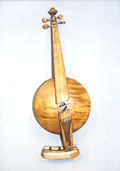
The Rondello Fiddle above can be Seen at Inverness Museum.
In an angling Competition, Grant achieved a world record cast of almost 55 yards.
In 1900, Grant, who was making his rods single-handed, could no longer cope with the demand and he sold the patent to Messrs Playfair of Aberdeen.
From this time, he centred his efforts on his other passion, fiddle-making. He invented the “Rondello”. This instrument had a distinctive disc shape, and was hollow throughout.
Alex began playing the violin at the age of 10. It is said that after his first violin lesson he refused to go back because the tone of the teacher’s violin was so bad. Allowing for some exaggeration, this story accurately reflects Grant’s interest in the sound quality of the instrument. After leaving school at the age of 8, he had a varied career as a ploughman, shepherd, draper, forester, grocer, butcher, gamekeeper, fisherman, hairdresser and Fishing Tackle Merchant.
He learned the drapery trade in Wales but returned to Scotland when his health broke down. And it was while he was employed in forestry work at Cullen that he got interested in different qualities of wood.
He had a passionate interest in what he called, “the rhythmic or vibratory qualities of wood”. and he was pre-occupied with sound quality.
These obsessions, passions and hobbies were to result in the invention of The Vibrating Rod for anglers and an instrument which he named the Rondello.
Grant, who was a close friend of Scott Skinner, composer and exponent of Strathspey playing, was leader for almost 40 years of The Highland Strathspey & Reel Society which was founded in 1903. In fact, “Battan” Grant was known as the Scott Skinner of the Highlands.
The earliest Grant fiddle known dates from 1896 Several of Grant’s fiddles and the Rondello are in the collection of Inverness Museum and Art Gallery.
Gateway To Health
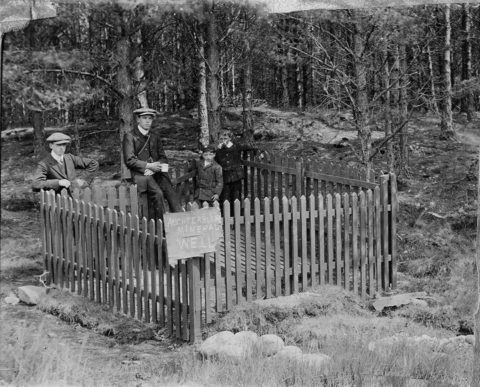
The village has always attracted many visitors. The high altitude – 850 feet above sea level – was regarded as being beneficial to heart cases and the resinous air of pine wood provided relief for chest complaints. . HONEY, once again being used widely for medicinal purposes, was produced in abundance. There were several bee keepers in the district whose honeys were in great demand up until the mid 1960’s.
A mineral well was situated at Auchterblair. The well was of chalybeate water, mineral water containing salts of iron reported by an analyst of the water to be “free from organic matter and entirely free from organic pollution. Locals used to drink directly from the spring using a metal cup on a chain.
Five wells are shown on an old estate map of the Carrbridge area.
Herbal remedies were made for human consumption. Bog myrtle brew was allegedly good for rheumatism.
When the Highland Railway extended North via Carrbridge to Inverness, the medical profession was recommending to those in search of health, to resort to the glens and straths of the Highlands, rather than the seaside.
In 1989, the Community Council issued a challenge to Britain’s water diviners to find the lost well of Carrbridge in an endeavour to build the image of Carrbridge as Strathspey’s holiday spa resort. But the well remains lost in the woods of Crannich.
1867 Map
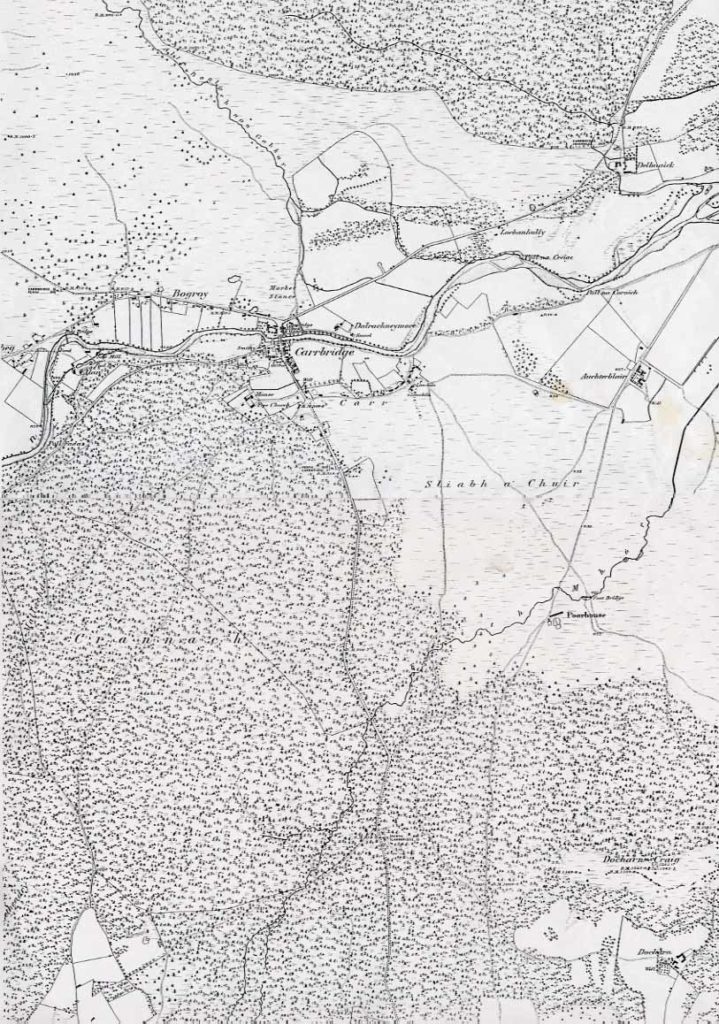
1900 Map
